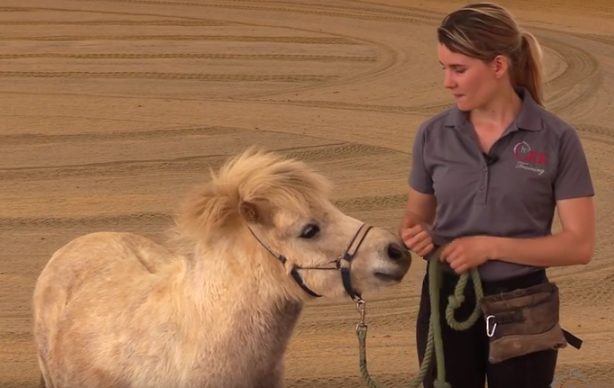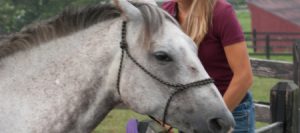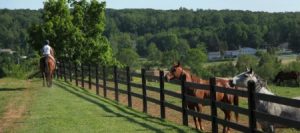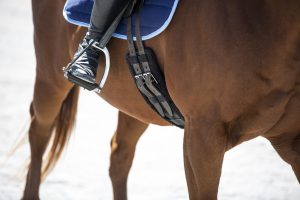Using food rewards in training horses often gets a bad reputation. Many people fear that it causes pushiness, nipping, or biting from the horse. However, food rewards can be a very valuable training asset, and when used correctly, can make any training a lot more effective.
One of the most important keys to success in training with food is to teach your horse good manners.
Here are 3 keys to teaching better manners around food:
#1 – Be aware of your horse’s behavior
#2 – Know what you do want your horse to do
#3 – Don’t reward unwanted behavior
For more help on teaching your horse better food manners, click below to play the video.
Now, I know you may have been told to simply avoid feeding your horse any treats, and the truth is, if you aren’t aware of how to train food manners, then this is probably the best advice. But with the knowledge of how to expect better manners from your horse, you can have a horse who takes treats politely and can have the ability to use food rewards as a powerful motivator in your training.
I would love to hear your comments and questions on this topic!
Callie














42 Responses
HI Callie. Interesting video. It looks a really good training technique. What are your views on ‘carrot stretches’? I’ve had someone recommend I do them with my horse who doesn’t have any notion of bending, but someone else I know had a problem with a horse who’d done them as he’d be constantly looking for treats. What’s your view? Caroline
Hi, Caroline. Just wanted to share my experience with my very food motivated mare. When I first started carrot stretches, she tended to try to grab, but she’s become very soft since then. I use carrot sticks, and she just sort of sucks them in. If I’ve run out of sticks and have to use short pieces or an alternative reward directly from my hand, I’ll revert to clicker training mode and get her to touch a target, click, and then offer a hand fed reward from in front. We do carrot stretches after each work session and she looks forward to them, but she’s figured out she can take her time and her reward will be at the end of the stretch without any need to grab. The carrot stick has become part of the exercise.
Kalli, thanks for that. I’ll maybe give it go and if I notice he’s ‘nudgeing’ for treats at other times I’ll have to try the clicker method. Caroline
Hi Caroline,
I work with one vet who also recommends carrot stretches, and I have done them with horses that learn these manners, but I will usually teach the manners first, and then have them stretch towards a target instead of towards the treat itself (especially if they have a tendency to get grabby with food)
By Amal
Hi Callie. Really good training to me before my horse
Thank you very much
This training topic came at a perfect time. My horse has developed over the last year (since I bought her) all the unwanted behaviors associated with treats – pushiness, biting, head bobbing, ears pinned, etc. I’m the main culprit! With this instructional video I can now begin working to repair what I broke. Thank you! The issue I/we have at the barn where my horse is boarded deals with my horse pinning her ears and trying to bite when someone comes close to her hay. It’s a bad behavior that needs to also be corrected. A little background – She is not in a pasture with other horses. She is stalled with her own run out and grazing lot. She gets 2-3 flakes of hay with her morning grain; several flakes mid-day and 2-3 flakes with her evening grain. She demonstrates the ears pinned and showing of teeth when her hay is given as well as if you approach the hay. Is there a recommendation for correcting this unwanted behavior? Or what may have caused it?
Hi Brenda,
I am going to link to a video here from a friend of mine, trainer and professor Angelo Telatin: http://www.angelotelatin.com/en/tips/
This video shows Angelo retraining food aggression during feeding time. This may help during feeding but probably won’t help in the aggression displayed when someone approaches her hay. The behavior was likely learned at some point in her life when food was scarce and she had to fight other horses for it. Therefore the aggressive behavior was reinforced. There are always multiple ways to change behavior. You could either stand by the hay and only allow her to approach and eat when she has nice ears. Sometimes this works, sometimes it creates more frustration. You could also approach with better food, i.e. some grain or treats, but only give it when you have nice ears. This would train the nice expression plus make your approach a positive event.
Perfect timing! I began teaching my mare some “tricks” using hand signals out of boredom during a long period of inactivity as she rehabs from an injury. I taught her to move to right or left in the cross-ties during grooming. I always reward her by standing straight in front of her with the food reward, but she is starting to nudge and even lightly nip as I groom her. I have been ignoring her or pushing her head away. Should I keep doing this, since she only gets food when I stand in front of her? Thanks Callie! Love your blog and videos!
Hi Susan,
You are right to ignore or push her head away, something to be aware of is that horses can learn a sequence of behaviors to basically get our attention and get us “back in the game.” It is so easy for this to happen and Little E even did it to me towards the end of this video. They give a nudge or push, then present the good behavior – head straight – expecting to be rewarded. When I notice this happening, I try to make my rewards more random and make sure the nudgeing does not become part of the “sequence”, in other words nudge, head away, treat. This may or may not be happening with your horse but I thought it was worth mentioning!
Callie this is enlightening. My instructor told me these things but not in depth like this. I hope it is possible for me to correct my horse’s behavior after these couple years of doing it incorrectly. And I wonder what you suggest doing with other well meaning people at the barn that always want to give my horse treats.
It is possible to correct, but usually takes longer when there has been more “reinforcement history”. I have certain horses in my barn that I know get nudgy very quickly so I have a rule with them that they only get treats during training. When someone asks, I offer to show them how to feed a treat rewarding good behavior, and almost everyone is happy to comply and learn!
Hi – Is it possible to do a video or write about buying a saddle regarding people who cannot afford a horse and who are put on different size school horses. I take dressage lessons at one barn and jumping lessons at another. Some blogs say don’t buy a saddle unless you have your own horse. Others say a wide saddle is best, then you can make adjustments with different pads to accommodate different horses. I have read that saddles with an adjustable gullet are not supposed to have their gullets changed every time you change to a different size horse. They’re supposed to be changed only when your horse ages and changes shape. Some say buy a high end used saddle when you can’t afford new. Are there truly no good inexpensive new saddles out there? The schooling saddles at my lesson barns are old with very worn and cracked leather. I would really like to have my own. Any information on this matter will be greatly appreciated. Thank you.
Hi Christina,
This is a great topic for a video, I have a few on saddles and fitting but not really addressing this topic yet – thank you!
Callie- this training video came at a perfect time and I can’t thank you enough. My mare has developed the bad behaviors described as associated with treats. Now I understand I am to blame. She was not accustomed to treats before I bought her a year ago. Based on your guidance I can now begin to turn this around. I do have a related issue I need some thoughts on. My mare is very possessive over her hay. She has begun pinning her ears and often times baring teeth when someone approaches her hay basket. She will do the same if you throw her a few flakes inbetween feelings. She is stalled with her own run out so she isn’t bothered or threatened by other horses. Do you have any thoughts on how to begin corrections?
Thanks for approaching this subject.
Would like to see a follow up on feed time behavior and carrot stretch behavior.
Hi Michelle,
Glad you enjoyed the video! Here is a link that is relevant, the first video talks some about feeding time behaviors: https://crktrainingblog.com/horse-training/angelo-telatin-feeding-positive-reinforcement/
I’ve used food rewards to bring the horse I lease to me in the field to halter her. The field has some really muddy spots right before the entrance to the barn (like in sucking off your boots muddy!) so it works better for me for her to put her head down to halter her with the treat at the end of the halter. When giving a treat in the barn, she has to be facing forwards.
I used to do the same. The other horses in the field caught on and I found myself surrounded by a herd and probably in a dangerous situation. She now knows that she will receive her treat when we are safely in the tack area and the other horses don’t bother us now.
Love this video with Little E. I have a very treat motivated horse. I had seen your prior video (that you showed clips from). Every once in a while Wildfire will get a little pushy or mouthy, but she has actually learned that when I tell her to “mind your manners” she needs to stand still with head forward and wait just like you have taught us.
I know some people at my barn may be frowning on me using treats to teach her new things. But I have found a treat that I can break into tiny pieces and she has learned so much and so quickly using treats. Thanks for the reminders how to use treats properly.
Thanks for this very good video. My one question is “how do you stop giving treats and maintain the good behavior?” (in the moment). For example, you are rewarding standing and facing straight ahead. Great! But you can’t keep feeding forever. How do you make the transition to patiently standing without a constant stream of treats?
Hi Diana,
The short answer is you just phase out the treats, feed them less and less often, until you are almost never feeding at all.
People have different opinions on how this is done, but I usually feed often until I am confident the horse has learned the behavior, then I start feeding less.
The technical name for this is “variable schedule of reinforcement” and it is the same piece of psychology that keeps people in casinos for hours with no rewards!
I have recently begun using feed rewards for one of the horses I’m training. I’m training halts in hand and what she does is nice halt but then quickly reaches around to grab the food. I will train her to keep her head straight as you did in the video but can I go on training halts meanwhile just try to be quicker than her? Or should I wait until she’s learned to stand straight?
Also, how do you reward for moving behaviours such as walk – just try to give it to them on the go? It just seems a bit trickier with the timing for me and often the horse gets distracted from walking and stops again to chew!
Hi Petra,
Great question! You can train them together, just halt and wait for the head to go straight, then feed. For moving behaviors, I will click (or say good, whatever your “that’s right” signal is) and whenever they hear that signal they know they can stop and get a treat. With consistency they do learn to always just wait for their treat with head straight!
Thank you Callie for your expertise. We have a small herd of 7 horses, 4 of which are together. My question is they are very food inclined, and will become pushy all at they same time. How do you chnage the behaviour of a herd? I am assuming not to give them any treats when they are all together!
Thanks
Cynthia
Hi Callie, I am 52 and have just purchased my first horse. This video has really opened my eyes . My gorgeous boy Sweeney does mouth my coat etc and i initially thought it was just affection or being cheeky. I can see now that I will need to be very mindful of how I interpret his behaviour and how I reward it. He is very food oriented and this video has given me a great place to start my education and his. I will definitely be looking for more of your wonderful videos . Lisa (Australia)
Glad you enjoyed the video Lisa!
Also, what small treat do you use for training ?
Hi Lisa, I use small commercial treats, grain, carrots or alfalfa cubes broken into small pieces.
I use Hearts for Horses treats. They are soft and easy to break and supposed to be all natural. They also benefit horse rescue. They are not cheap, but I can break each one into 10-15 pieces depending on how small I want them, so in the long run I think I’m saving money or breaking even over the cost of the commercial store bought ones. Good luck training.
HI Callie — this topic is one I need to live by. — as I begin to train my horse away from the bad habits that even I helped to perpetuate, what do I do when I am not at the barn? It’s not possible for me to tell each person at the barn that I no longer want Asher to reach out and nip for treats or to crowd me for treats. He’s a friendly horse and people like to give him treats and pet him. Shall I make a little sign to post at his stall that reads: Asher in training, p,ease do not hand feed? Or something like that ?
Absolutely! The sign is really a good idea and a gentle reminder for others at your barn.
I’m trying to get away from using sugar cubes and peppermints for rewards. I’m gradually eliminating them from the “menu”.
I have been using carrots more. Cutting them into tiny pieces and some other small more nutritious nuggets.
Are carrots and apples good for horses?
In small quantities yes, carrots and apples are fine, but they are high in sugar so too many is a problem, especially for horses that should avoid sugar – the thicker, cresty neck types. How much is too much is the real question… I wouldn’t give more than one apple or a handful of carrots.
Ok, thank you for your response.
My Congo is a 17.3 Dutch Warmblood, 17 years old that get’s worked at least 5 X week.
I suspect I’ve been giving too much sugar. He is an easy keeper and tends to get chunky without steady work.
Are carrots and apples good for horses If you are working with a nutritionist carrots and apples become part of the horses regular diet to fill nutritional needs. When I was told to feed 3-4 carrots a day for teeth health I was like What! Please work with a nutritionist before diving in especially if your horse falls in the avoid sugars group.
If you are working with a nutritionist carrots and apples become part of the horses regular diet to fill nutritional needs. When I was told to feed 3-4 carrots a day for teeth health I was like What! Please work with a nutritionist before diving in especially if your horse falls in the avoid sugars group.
Hello Callie, thank you I enjoyed your video. We have our first pony, she is well behaved and quiet. I have been thinking of starting the rewards with food. I’m new to this so thank you your video was so helpful as she was nudging me and my pockets (gently) but I thought this will lead to something and I didn’t know how to work on this. I have young children and they are always on the seen doing things to the pony that I’m so pleased that the pony has been good with. Just wondering if I start this technique what happens if I run out of food? I think she will get confused and wonder why I’m not treating her. And then get frustrated with me. Does this mean I also need food for all things we do with her – brushing?? Rugs on/off. I started with food to help her walk to an area that she doesn’t want to go too. How can I use the food to get her to walk? Also I tried the technique after your video which was great, I gave her treats when she had her head straight and was putting her head quiet low – is that a good position? I preferred that to nudging me. What happens also when my children are around and don’t necessarily have the treats… I like the idea but thinking practically of lots of situations with children/treats/things happening/ Also if we walk, halt, trot her on lead in the arena… how often then do we give a treat?? Thank you Casey.
Hi Casey, You won’t need to use food all the time. I use food most often to teach something new, work through something scary, or add reinforcement to a very important behavior (such as standing still at the mounting block).
Head straight and low is a great position to reward. Also, when your children are around without treats she should act the same as she would if they did have one in their pocket – leave them alone and not be nudgy as long as she understands the food manners. (that food never comes from being nosy or pushy)
I treat often when I am teaching something new, starting with for each repetition, then less as the behavior becomes better learned.
Hope this helps! Callie
Hi Callie. Thanks for a very interesting video. I have worked on this quite a bit with my food motivated horse. I’ve been able to teach him to wait and turn his head to the side when I put treats in his bucket. I’ve also taught him that, when I have treats in my pockets or hands for him, he will turn his head to the side. I’m wondering if I can translate that teaching to the mounting block – he tends to like to move away before I get on, or, at the very least , the minute that I put my foot in the stirrup and swing my leg up over….
Hi Callie,
Great information! I have successfully taught my gelding that he only gets the reward when he’s facing straight, but he’s still very assertive with his mouth when taking the treat. You mentioned that we want “soft lips” and I certainly do, but do you have a video to show how to achieve that part of the behavior? Thanks!
Hi Amber, we don’t have a video about that here on the blog only in our Balanced Riding Course program. Basically, you’ll want to hold the treat or the food on the nose until he is quieter with his lips, once they stop moving then you give the reward. Hope that helps!
-Julia, CRK Training Community Manager